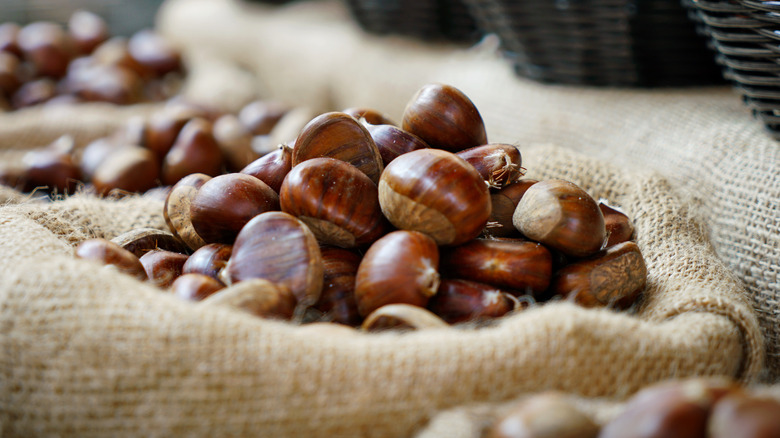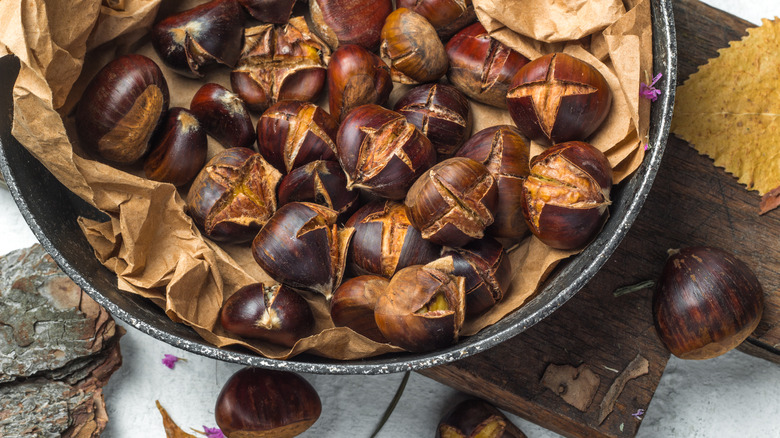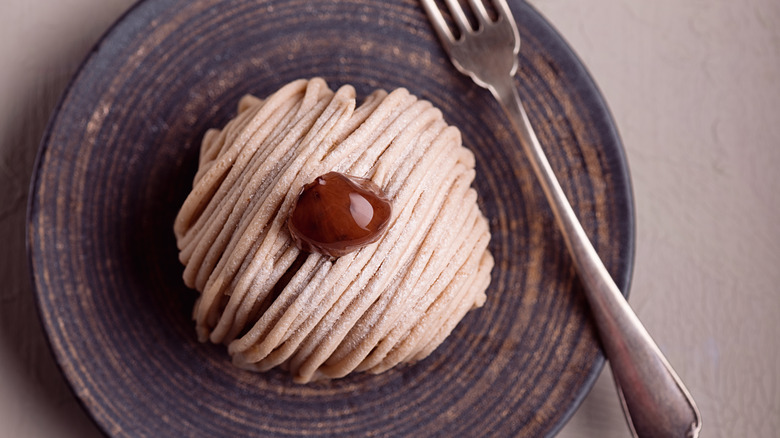You Should Think Twice Before Eating Raw Chestnuts
Finding fresh chestnuts at a specialty or farmers market is exciting, considering their short season and the fact that they're not available at the average supermarket. Typically, you can only find fresh chestnuts between the months of October and December, which makes them a coveted and iconic ingredient during the winter season. You may often picture chestnuts roasting over an open fire, thanks to Nat King Cole's velvety crooning in "The Christmas Song," but you can actually consume them raw — it just may not be the best idea for some folks.
In their raw state, chestnuts contain high levels of tannic acid, which can irritate the stomach and damage the liver and kidneys. Anyone with medical issues involving these organs should steer clear of raw chestnuts. This goes for those who are pregnant, as well. The only way to completely eliminate the risk of stomach issues is to cook the nuts, which causes their tannic acid content to dissipate.
In addition to the health risk, chestnuts are bitter and hard in their raw state, and cooking them brings out their natural sugars and softens them, resulting in a soft and sweet treat that's much more pleasant to enjoy. Unless you're extremely curious and are prepared for the potential consequences, enjoying the nuts after boiling or roasting them is a better choice than eating them raw.
How to prep and cook chestnuts
When preparing fresh chestnuts, the first step is removing the very tough skin or shell on the outside of each nut, whether you're using them raw or want to cook them. The skin is difficult to remove from raw chestnuts, and it takes time to shell a whole bucket, so be patient. On the other hand, if you roast the nuts, the skin will come right off after cooking.
To roast chestnuts, first score an "x" in the outer shell of each nut. Skipping this step could cause the nuts to explode as they cook. Next, blanch the nuts by cooking them in boiling water for about five minutes. Drain and dry the chestnuts, then roast them in a pan in the oven for about 30 minutes, or until the skins are visibly curled back from the interior where you've scored them. Once the nuts are cooked, you should be able to easily remove the peel and eat them as-is, or use them in recipes. You can also flavor them with butter, herbs, and spices before they go into the oven for the perfect festive party snack.
Cooking and baking with chestnuts
As delicious as they are straight from the oven, chestnuts can star in a great number of dishes and desserts. The cooked nuts have a soft and starchy texture, similar to a cooked potato, with an earthy, nutty, delicately sweet flavor that's instantly comforting. They make a delicious addition to stuffing for your Thanksgiving or Christmas table, or they can bulk up autumn-inspired salads. They also work well in pastas, as a soup garnish, or tossed with roasted veggies like Brussels sprouts. Puréed chestnuts can be made into a sweetened paste that is perfect for spreading on crêpes, scones, and toast. Chestnut paste is also a key ingredient in the classic French dessert Mont Blanc.
If you can't get your hands on fresh chestnuts, they're available in canned, jarred, or packaged form from a variety of brands. For the most part, they are sold pre-cooked, peeled, and ready to eat or cook with, making them very convenient. Outside of the realm of whole chestnuts, you can also buy chestnut flour for use in breads, cakes, tarts, pastry crusts, and even homemade pasta. Made of nothing but ground chestnuts, this flour is also gluten-free, and may be worth seeking out for those of us who can't eat wheat flour.



